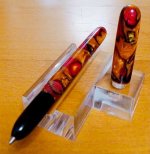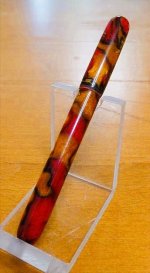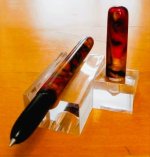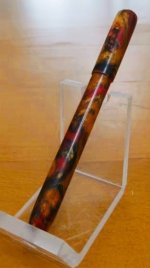NGLJ
Member
The Hinze tenon cutter is clearly aimed at making fountain pens, which is fine. However, if you want to make ballpoint (Cross and Parker) and rollerball (Schmidt) you also have to make tenons to be threaded. Like many of us, I grew tired of cut a little, measure, and so on, and when cutting say a 7 mm tenon it doesn't take much to go a little too far! So, I got to thinking about how I could adapt the Hinze tenon cutter to cut 7 mm, 8 mm, 9 mm and 3/8" tenons without drilling a 6 mm hole for the shaft. First of all the kit doesn't come with 7 mm, 8 mm and 3/8" bushings. A quick message to Rick Herrell and that took care of that.
At first I thought in terms of replacing the 6 mm shaft with shafts with 6 mm on one end, enough to fit snugly in the head of the cutter, and 2 or 2.5 mm the rest of the way. Even assuming that this could be done, it is debatable how much extra stability it might bring because of the flexibility of the shaft. Since there is no shaft to help guide the cutter, instead of the using a Jacobs chuck to hold the cutter and advance it using the tailstock handle, I opted for using a tailstock ER32 Tap and Die holder (again from Rick). By locking down the tailstock and quill it minimizes any movement. You are now free to advance the cutter slowly along the shaft of the tap and die holder, at the same time holding on tight to minimize any vibration. This was done at about 800 RPM. I chose this speed because it was the minimum of the top range on my lathe. I didn't try lower speeds, which might help to reduce vibration, and give a cleaner cut.
As always, setup is still important. This was done by drilling a small 6 mm hole in the end of the workpiece, enough to securely locate the 6 mm shaft. This is removed before threading. After that the process is as normal to set the distance to the cutter. I discovered that with the cutter as far in as possible that cutting a 7 mm tenon isn't going to work. It will be oversized. So, I replaced the cutter with a slightly larger cutter. If 7 mm is of no interest, then that isn't necessary. I then discovered that it cut too much undersized, no doubt due to vibration and holding by hand. I compensated by working out how much the cutter needed to be moved, and set it using the bushing and a feeler gauge (7 thou).
As I went up in sizes the cuts were much closer (no doubt lower percentage error). If the cut was a little oversized I went back over it by angling the cutter in very slightly. There is very little slop in the tap and die holder, but enough to take a small amount off, and clean up up the cut at the same time. In all cases I threaded the tenon to validate that the tenon is usable. I haven't tried this with all typical materials, eg. acrylic, Alumilite, ebonite, Delrin, etc.. I did use Delrin and ebonite, and made usable threaded tenons. Next I will make a pen using this approach to see if there are unforeseen gotchas!
At first I thought in terms of replacing the 6 mm shaft with shafts with 6 mm on one end, enough to fit snugly in the head of the cutter, and 2 or 2.5 mm the rest of the way. Even assuming that this could be done, it is debatable how much extra stability it might bring because of the flexibility of the shaft. Since there is no shaft to help guide the cutter, instead of the using a Jacobs chuck to hold the cutter and advance it using the tailstock handle, I opted for using a tailstock ER32 Tap and Die holder (again from Rick). By locking down the tailstock and quill it minimizes any movement. You are now free to advance the cutter slowly along the shaft of the tap and die holder, at the same time holding on tight to minimize any vibration. This was done at about 800 RPM. I chose this speed because it was the minimum of the top range on my lathe. I didn't try lower speeds, which might help to reduce vibration, and give a cleaner cut.
As always, setup is still important. This was done by drilling a small 6 mm hole in the end of the workpiece, enough to securely locate the 6 mm shaft. This is removed before threading. After that the process is as normal to set the distance to the cutter. I discovered that with the cutter as far in as possible that cutting a 7 mm tenon isn't going to work. It will be oversized. So, I replaced the cutter with a slightly larger cutter. If 7 mm is of no interest, then that isn't necessary. I then discovered that it cut too much undersized, no doubt due to vibration and holding by hand. I compensated by working out how much the cutter needed to be moved, and set it using the bushing and a feeler gauge (7 thou).
As I went up in sizes the cuts were much closer (no doubt lower percentage error). If the cut was a little oversized I went back over it by angling the cutter in very slightly. There is very little slop in the tap and die holder, but enough to take a small amount off, and clean up up the cut at the same time. In all cases I threaded the tenon to validate that the tenon is usable. I haven't tried this with all typical materials, eg. acrylic, Alumilite, ebonite, Delrin, etc.. I did use Delrin and ebonite, and made usable threaded tenons. Next I will make a pen using this approach to see if there are unforeseen gotchas!




